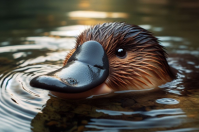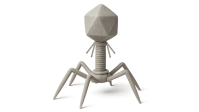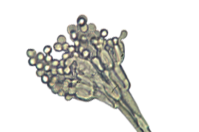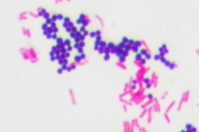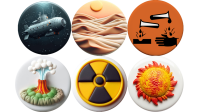10th grade
Activities:
- Examine key mammalian traits such as warm-bloodedness, mammary glands, and skin coverings
- Investigate evolutionary adaptations like jawbone transformation and respiratory systems
- Compare heart structure and birth methods across different mammal groups
- Sort species on a phylogenetic tree and classify them as monotremes, marsupials, or placentals
- Analyze historical descriptions to identify mammals based on clues and context
- Practice scientific reasoning through elimination, deduction, and classification
Activities:
- Identify plant, animal, and bacterial viruses using hints (drag & drop)
- Explore the structure of the tobacco mosaic virus
- Find all the ways plant viruses can enter through wounds or openings
- Examine common symptoms of plant viral infections
- Hover over the HIV model to study animal virus structure
- Compare two main entry pathways: membrane fusion and endocytosis
- Observe how viruses replicate, assemble, and exit the host cell
- Match human viral symptoms with the correct virus and transmission method
- Study bacteriophages and how they inject DNA into bacteria
- See plaques (holes) on Petri dishes as signs of phage infection
- Answer the big question: how do viruses enter the cell? (Olympiad-style challenge)
- Learn about viroids (naked RNA) and prions (infectious proteins)
- Compare DNA vs RNA, and how viruses use genetic information
- Classify viruses in a table based on descriptions
- Contrast lytic vs lysogenic cycles and their role in gene transfer
- Discover beneficial viruses in symbiosis with parasitoid wasps
Activities:
- Explore the major fungal groups, including Basidiomycota, Ascomycota, Chytridiomycota, Mucoromycota, Zoopagomycota, and Fungi Imperfecti.
- Watch simple animations that show how different types of spores form, such as ascospores, basidiospores, zygospores, and zoospores.
- Build a growing mind map of fungal systematics to understand classification step by step.
- Complete interactive diagrams of spore formation by dragging illustrations into the correct places.
- Identify the zoospore of chytrids and place it in the correct position.
- Match each fungal group with either its representative organisms or the traces they leave behind.
- Read a short piece of online pseudoscience called “Beware the Yeast” and decide which paragraphs contain scientific inaccuracies. Compare their choices with expert feedback.
Fungal Diversity Explained: From Chytrids to Basidiomycetes on YouTube.
Activities:
- Reconstruct the nitrogen, sulfur, and phosphorus cycles step by step — using hints, visual prompts, and logical reasoning to complete each process.
Activities:
- Understand the basics of biological systematics
- Distinguish between gram-positive and gram-negative bacteria
- Explore prokaryotes without cell walls and archaeal cell walls
- Model cell wall structures through interactive tasks
Activities:
- Discover the unique structure of bacterial genomes, including the nucleoid and plasmids
- Explore horizontal gene transfer via transformation, transduction, and conjugation
- Learn how gene transfer shapes bacterial evolution and impacts all life on Earth
- Debunk common myths about GMOs and understand their real-life benefits
- Analyze misleading claims about genetic modification and defend scientific facts
Activities:
- Discover different bacterial reproduction methods: binary fission, budding, fragmentation, and spore formation
- Understand the roles of endospores, exospores, myxospores, and akinetes in survival and reproduction
- Explore how bacterial colonies form on solid and liquid media
- Learn why bacteria reproduce so rapidly thanks to their surface-area-to-volume ratio
- Reinforce their knowledge with an engaging interactive exercise
Microbial Survival Strategies
Activities:
- Explore why high salinity poses a danger and how prokaryotes resist osmotic stress
- Analyze how heat affects proteins and how microbes cope with extreme temperatures
- Discover why too much light is toxic for photosynthetic organisms
- Identify survival strategies of deep-sea barophiles under extreme pressure
- Examine microbial tactics to survive antibiotic exposure and slow resistance
- Learn how microbes handle deadly pH levels in acidic or alkaline environments
- Investigate radiation resistance in Deinococcus radiodurans and rank common sources
- Uncover adaptations for surviving desert heat, cold, dryness, and starvation
